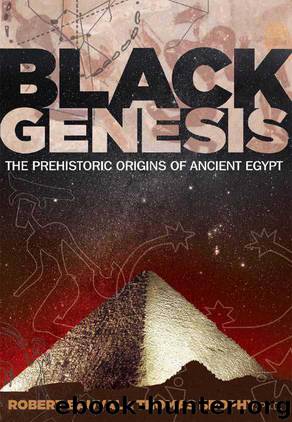Black Genesis by Robert Bauval

Author:Robert Bauval
Language: eng
Format: mobi, epub
Tags: Ancient Mysteries/Egypt
ISBN: 9781591439738
Publisher: Inner Traditions / Bear & Company
Published: 2011-03-27T13:00:00+00:00
OUT OF THE SAHARA AND INTO THE NILE VALLEY
For many years a team of anthropologists headed by Rudolph Kuper and Stefan Kröpelin of Cologne University in Germany have been studying prehistoric sites and climatic changes in the Egyptian Sahara and the sub-Sahara in Chad, Sudan, and Libya. After analyzing radiocarbon samples from hundreds of prehistoric archaeological sites, they concluded that the climatic changes correlated with the movement of prehistoric people during the past twelve thousand years. The evidence also showed that there was a stable humid period from 8500 BCE to 5300 BCE, after which the people and their cattle—the same cattle people of Nabta Playa, Gilf Kebir, and Jebel Uwainat?—escaped the drying of the Sahara and spread pastoralism throughout the continent, and, perhaps, add Kuper and Kröpelin, “helped trigger the emergence of pharaonic civilization along the Nile.”53 This view is today shared by many anthropologists, including climatologists such as Professor Peter B. deMenorcal of Columbia University, who affirmed that “however fast the drying occurred, it pushed people out of north-central Africa, and that climatically forced migration might have led to the rise of the Pharaohs and Egyptian civilization.”54
The speed at which the Sahara changed from a lush green savanna to the barren, arid, waterless desert that it is today has been a bone of contention among climatologists for many decades. In the early years geoclimatologists were generally gradualists—that is, against the idea of any rapid changes. More recent measuring methods, however, have indicated very swift changes in some locations of the Sahara. Then, in 2005–2006, Kuper and Kröpelin studied deep core samples from Lake Yoa, in the Tibesti-Ennedi region of northeastern Chad, and found evidence there for a slow desertification that occurred over several millennia from about 10,000 BCE to 3500 BCE. It seems, then, that there was a combination of very rapid change in some areas and more gradual regional change as the monsoon pattern moved and continuously reshaped itself. In any case, it seems the drying process eventually drove the prehistoric people out of the Sahara—meanwhile giving them ample time across many generations to develop animal domestication; basic agriculture; art; primitive sign writing; the knowledge of how to move large stones and construct complex megalithic structures; and knowledge of the simple principles of navigation, orientation, and timekeeping with the sun and stars. In other words, they acquired the practical and intellectual tools for building a civilization by the time they migrated into the Egyptian Nile Valley around 3500 BCE.
Let us now take a closer look at Lake Yoa near the Tibesti-Ennedi highlands. This region warrants a closer investigation, for it lies in the extended direction of Bergmann’s Abu Ballas Trail, which has as its starting point Dakhla oasis and passes through the Gilf Kebir and Jebel Uwainat massifs.
Download
This site does not store any files on its server. We only index and link to content provided by other sites. Please contact the content providers to delete copyright contents if any and email us, we'll remove relevant links or contents immediately.
| African-American Studies | Asian American Studies |
| Disabled | Ethnic Studies |
| Hispanic American Studies | LGBT |
| Minority Studies | Native American Studies |
Cecilia; Or, Memoirs of an Heiress — Volume 1 by Fanny Burney(31332)
Cecilia; Or, Memoirs of an Heiress — Volume 3 by Fanny Burney(30934)
Cecilia; Or, Memoirs of an Heiress — Volume 2 by Fanny Burney(30889)
The Great Music City by Andrea Baker(21280)
We're Going to Need More Wine by Gabrielle Union(18072)
Bombshells: Glamour Girls of a Lifetime by Sullivan Steve(13107)
Pimp by Iceberg Slim(12929)
All the Missing Girls by Megan Miranda(12747)
Fifty Shades Freed by E L James(12449)
Norse Mythology by Gaiman Neil(11882)
Talking to Strangers by Malcolm Gladwell(11875)
Crazy Rich Asians by Kevin Kwan(8348)
Mindhunter: Inside the FBI's Elite Serial Crime Unit by John E. Douglas & Mark Olshaker(7833)
The Lost Art of Listening by Michael P. Nichols(6471)
Enlightenment Now: The Case for Reason, Science, Humanism, and Progress by Steven Pinker(6405)
Bad Blood by John Carreyrou(5767)
The Four Agreements by Don Miguel Ruiz(5510)
Weapons of Math Destruction by Cathy O'Neil(5034)
We Need to Talk by Celeste Headlee(4868)
